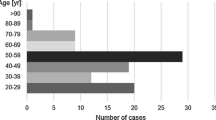Abstract
Purpose
To evaluate the prevalence of anatomical variations in the circle of Willis predisposing to cerebral ischemia during intraoperative closure of a carotid artery.
Materials
Anatomy of the cerebral arteries of 92 deceased was assessed by angiography and permanent silicone casts. Cerebral ischemia during closure of a carotid artery with patent contralateral internal carotid artery (ICA) was considered possible in cases of simultaneous nonfunctioning anterior communicating artery (diameter <0.5 mm) and ipsilateral posterior communicating artery (PComA) (diameter <0.5 mm or fetal type posterior cerebral artery). In cases of contralateral ICA occlusion, cerebral ischemia was considered possible if ipsilateral PComA was nonfunctioning.
Results
Cerebral ischemia during closure of the right or left carotid artery with patent contralateral ICA was estimated to be possible in 16 (17.4%) and 13 (14.1%) cases. In cases of occluded contralateral ICA, the corresponding numbers were 55 (59.8%) and 49 (53.3%). A review of magnetic resonance and catheter angiographies also identified other variants of the circle of Willis with increased risk.
Conclusions
Incomplete circle of Willis predisposes approximately one-sixth of individuals to cerebral ischemia during transient closure of carotid artery but the risk is more than threefold in case of contralateral ICA occlusion.





Similar content being viewed by others
References
Alpers BJ, Berry RG, Paddison RM (1959) Anatomical studies of the circle of Willis in normal brain. AMA Arch Neurol Psychiatry 81:409–418
Bagan P, Vidal R, Martinod E, Destable MD, Tremblay B, Dumas JL, Azorin JF (2006) Cerebral ischemia during carotid artery cross-clamping: predictive value of phase-contrast magnetic resonance imaging. Ann Vasc Surg 20:747–752. doi:10.1007/S10016-006-9126-8
Battacharji SK, Hutchinson EC, McCall AJ (1967) The Circle of Willis—the incidence of developmental abnormalities in normal and infarcted brains. Brain 90:747–758. doi:10.1093/brain/90.4.747
Berman SS, Bernhard VM, Erly WK, McIntyre KE, Erdoes LS, Hunter GC (1994) Critical carotid artery stenosis: diagnosis, timing of surgery, and outcome. J Vasc Surg 20:499–508 discussion 508–510
Gumerlock MK, Neuwelt EA (1988) Carotid endarterectomy: to shunt or not to shunt. Stroke 19:1485–1490
Halliday A, Mansfield A, Marro J, Peto C, Peto R, Potter J (2004) Prevention of disabling and fatal strokes by successful carotid endarterectomy in patients without recent neurological symptoms: randomised controlled trial. Lancet 363:1491–1502. doi:10.1016/S0140-6736(04)16146-1
Halsey JH Jr (1992) Risks and benefits of shunting in carotid endarterectomy. The International Transcranial Doppler Collaborators. Stroke 23:1583–1587
Hoksbergen AW, Legemate DA, Csiba L, Csati G, Siro P, Fulesdi B (2003) Absent collateral function of the circle of Willis as risk factor for ischemic stroke. Cerebrovasc Dis 16:191–198. doi:10.1159/000071115
Hoksbergen AW, Legemate DA, Ubbink DT, Jacobs MJ (2000) Collateral variations in circle of willis in atherosclerotic population assessed by means of transcranial color-coded duplex ultrasonography. Stroke 31:1656–1660
Kim GE, Cho YP, Lim SM (2002) The anatomy of the circle of Willis as a predictive factor for intra-operative cerebral ischemia (shunt need) during carotid endarterectomy. Neurol Res 24:237–240. doi:10.1179/016164102101199846
Krabbe-Hartkamp MJ, van der Grond J, de Leeuw FE, de Groot JC, Algra A, Hillen B, Breteler MM, Mali WP (1998) Circle of Willis: morphologic variation on three-dimensional time-of-flight MR angiograms. Radiology 207:103–111
Laman DM, Wieneke GH, van Duijn H, van Huffelen AC (2002) High embolic rate early after carotid endarterectomy is associated with early cerebrovascular complications, especially in women. J Vasc Surg 36:278–284. doi:10.1067/mva.2002.125796
Lee JH, Choi CG, Kim DK, Kim GE, Lee HK, Suh DC (2004) Relationship between circle of Willis morphology on 3D time-of-flight MR angiograms and transient ischemia during vascular clamping of the internal carotid artery during carotid endarterectomy. AJNR Am J Neuroradiol 25:558–564
Macchi C, Catini C, Federico C, Gulisano M, Pacini P, Cecchi F, Corcos L, Brizzi E (1996) Magnetic resonance angiographic evaluation of circulus arteriosus cerebri (circle of Willis): a morphologic study in 100 human healthy subjects. Ital J Anat Embryol 101:115–123
Manninen H, Tulla H, Vanninen R, Ronkainen A (2008) Endangered cerebral blood supply after closure of left subclavian artery: postmortem and clinical imaging studies. Ann Thorac Surg 85:120–125. doi:10.1016/j.athoracsur.2007.08.035
Merkkola P, Tulla H, Ronkainen A, Soppi V, Oksala A, Koivisto T, Hippelainen M (2006) Incomplete circle of Willis and right axillary artery perfusion. Ann Thorac Surg 82:74–79. doi:10.1016/j.athoracsur.2006.02.034
Moritz A, Koci G, Steinlechner B, Holzenbein T, Nasel C, Grubhofer G, Dworschak M (2007) Contralateral stroke during carotid endarterectomy due to abnormalities in the circle of Willis. Wien Klin Wochenschr 119:669–673. doi:10.1007/s00508-007-0837-9
Riles TS, Imparato AM, Jacobowitz GR, Lamparello PJ, Giangola G, Adelman MA, Landis R (1994) Causes of perioperative stroke after carotid endarterectomy: special considerations in symptomatic patients. Ann Vasc Surg 15:19–24
Salvian AJ, Taylor DC, Hsiang YN, Hildebrand HD, Litherland HK, Humer MF, Teal PA, MacDonald DB (1997) Selective shunting with EEG monitoring is safer than routine shunting for carotid endarterectomy. Cardiovasc Surg 5:481–485. doi:10.1016/S0967-2109(97)00044-6
Weman SM, Salminen US, Penttila A, Mannikko A, Karhunen PJ (1999) Post-mortem cast angiography in the diagnostics of graft complications in patients with fatal outcome following coronary artery bypass grafting (CABG). Int J Legal Med 112:107–114. doi:10.1007/s004140050211
Author information
Authors and Affiliations
Corresponding author
Rights and permissions
About this article
Cite this article
Manninen, H., Mäkinen, K., Vanninen, R. et al. How often does an incomplete circle of Willis predispose to cerebral ischemia during closure of carotid artery? Postmortem and clinical imaging studies. Acta Neurochir 151, 1099–1105 (2009). https://doi.org/10.1007/s00701-009-0468-1
Received:
Accepted:
Published:
Issue Date:
DOI: https://doi.org/10.1007/s00701-009-0468-1




